It used to be about what you know. Now it’s not only about what you know, but how fast you need to know it!
And that’s why “Knowledge velocity” is trend #8 of my “23 Trends for 2023.”
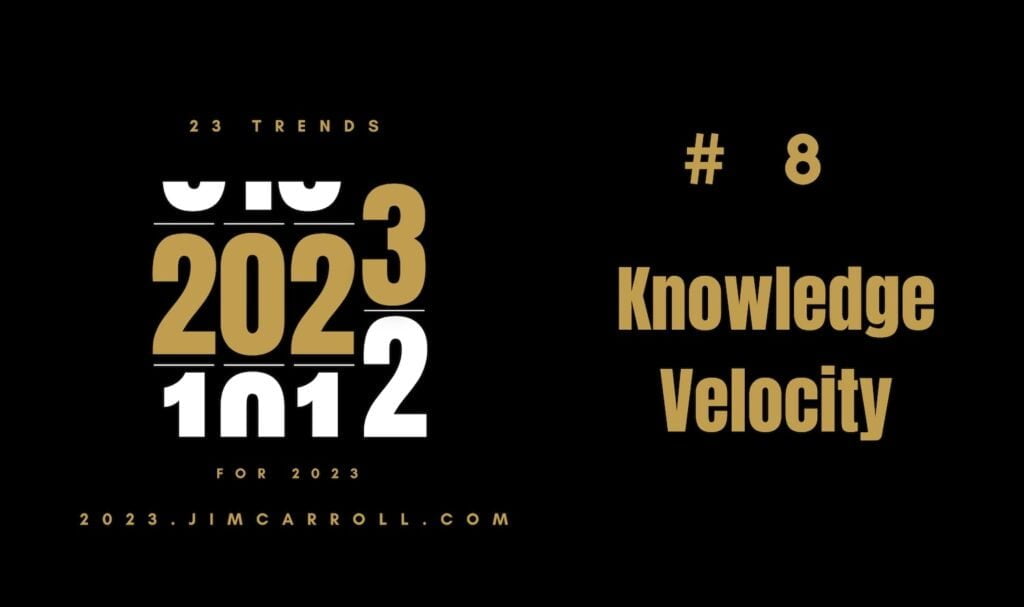
And indeed, the acceleration of knowledge will continue to be one of the most defining trends that organizations will face in the year to come – particularly as they continue to try to manage the impact of trend #9 – faster work back pushback!
What is knowledge velocity?
Buckminster Fuller spoke of the “Knowledge Doubling Curve” in 1982:
- he suggested that in 1900, human knowledge doubled approximately every 100 years
- by the end of 1945, the rate had come down to every 25 years
- and by 1982, every 13 months
1982 looks quaint – a fellow futurist, Ray Kurzweil, has suggested that with the arrival of the Internet it is now doubling every 12 hours – think about that! Another way to think about this is that just as radioactive materials have a half-life, so too does knowledge – that’s the length of time that it takes before half of a set of knowledge is made obsolete or superseded by new knowledge. And the half-life of knowledge is decreasing at an accelerating pace.
The Half-Life of Facts: Why Everything We Know Has an Expiration Date
Scientific knowledge has grown exponentially over the last 200 years, doubling every nine years, and 1.9 million articles were published in 2012. Even single topics can be daunting: there were about 66,500 articles on graphene since 2005. Assuming 2 hours to understand each article, it would take more than 40 years, working 8 hours a day, to read the current graphene literature. This raises the question of how our Materials Design Engine should interact with the global knowledge base.
In 1982, futurist and inventor R. Buckminster Fuller estimated that up until 1900, human knowledge doubled approximately every century, but by 1945 it was doubling every 25 years. And by 1982, it was doubling every 12-13 months. In retrospect, this may sound a little quaint since experts now estimate that by 2020, human knowledge will double every 12 hours. But the real question is, “How is it making us smarter?”
These numbers are, of course, extremely subjective – there is no way to measure such a metric! And given the widespread presence of conspiracy theories around us, it can be said that we aren’t seeing the generation of knowledge but the manufacturing of idiocy.
Why it matters
There is no doubt that we live in an era of knowledge acceleration. That’s why I’ve always suggested that what people and organizations need to concentrate on is what I call just-in-time knowledge – getting the right knowledge, at the right time, for the right purpose.
The acceleration of knowledge has pretty profound implications for 2023 and going forward because organizations will find it increasingly difficult to train people in the skills required to do their job and far more challenging to find the niche skills that are necessary to get things done. The continued arrival of new knowledge leads to new knowledge demands that didn’t exist before, and if organizations don’t identify and align with the new knowledge trends impacting them, they will fall behind.
When knowledge accelerates, skills accelerate – and you won’t have the skills you need to get things done! THIS is what is happening to your workforce:
- Rapid knowledge obsolescence
- Rapid knowledge emergence
- The disappearance of existing careers due to 1)
- The rapid emergence of new careers due to 2)
- An ongoing need for continuous knowledge replenishment because of 1-4
- A need to get the right skills at the right time for the right purpose because of 1-5
- A massively increased challenge in getting those skills!
- The fast emergence of new micro-careers because of specialized knowledge
- An economy that succeeds through knowledge deployment
- A fundamental transformation in knowledge delivery
I use this structure with examples on stage all the time:
- the volume of medical knowledge was doubling every 8 years before Covid; it’s now doubling every 78 days. Hospitals and medical care companies are having difficulty in keeping people up to date, and challenges in recruiting specialized staff
- the typical machinist in a factory almost had to be able to do trigonometry in their heads due to the sophistication of the process. In manufacturing there is not a job shortage – there is a skills shortage
- law firms and the legal profession continually struggle with the arrival of new knowledge. I’ve used this image to out that into perspective.
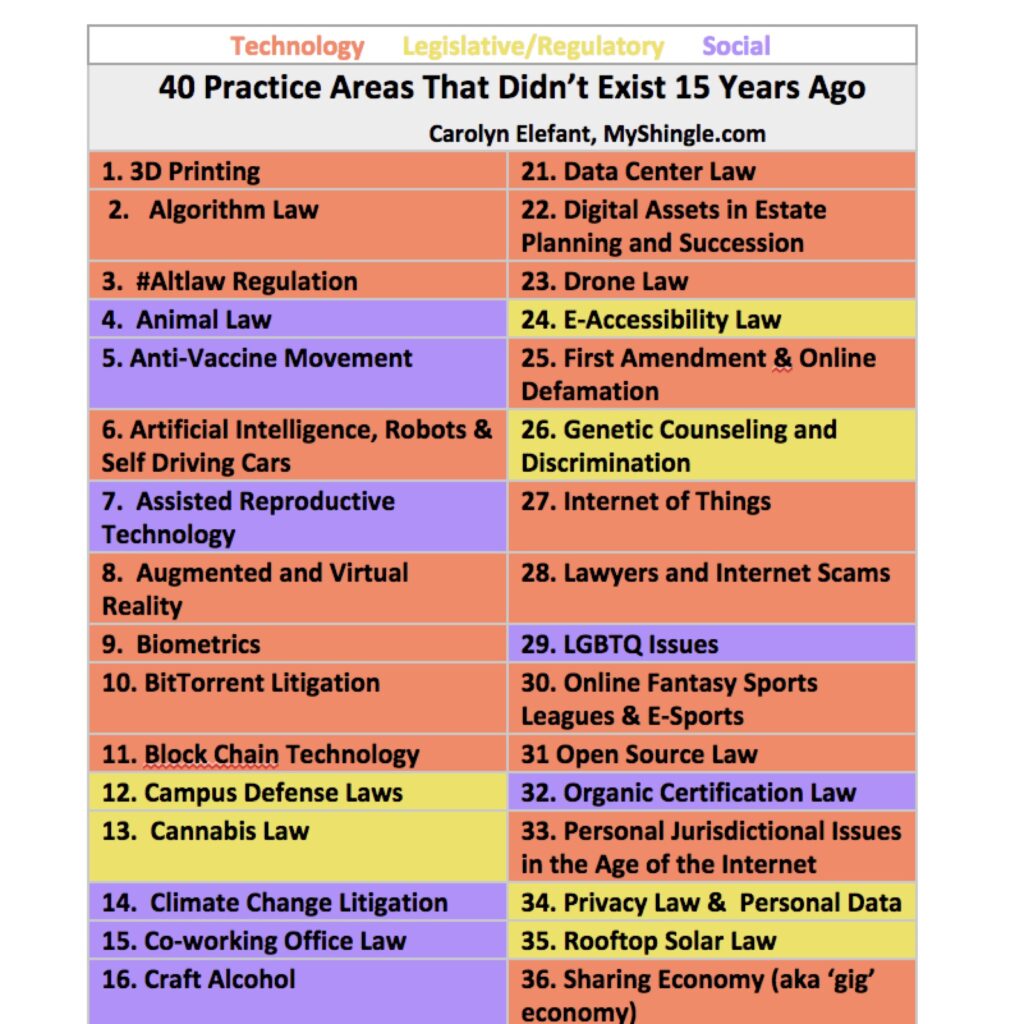
Simply put, your old corporate knowledge won’t cut it – and new knowledge is coming at you faster!
Examples of the Acceleration of Knowledge
So consider the law profession – and the Federal Register. What is it? It’s the register of court decisions, specifically: “Federal Reporter (F., F. 2d, F. 3d): Includes decisions of the federal district and appellate courts through 1925. There is no equivalent official reporter; this is the only comprehensive printed source for Circuit Court appellate opinions.”
Now consider this tweet. It’s indicative of how quickly new federal court cases – which become the basis for much law going forward – come to our world. How is any lawyer supposed to be able to keep up?

Now look at his follow-up tweet: there’s a bit of levity there, but also some staggering insight into how quickly case law is growing;
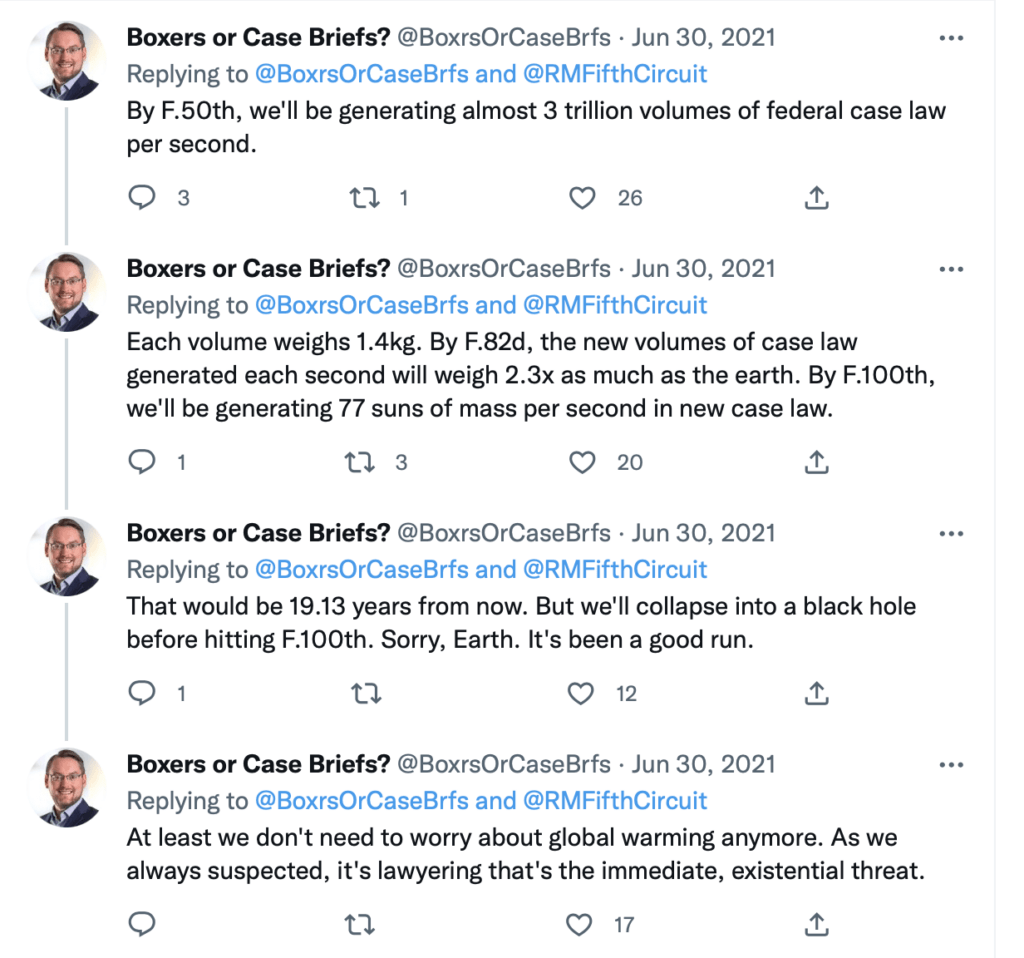
Consider the impact of knowledge acceleration on the typical construction worker with the arrival of new materials, technologies, methodologies, and construction concepts:
I tell the same story here in terms of an HVAC contractor who arrived in our home years ago, only to be confronted with a new-fangled, Internet-connected thermostat.
The story of knowledge in the video tells itself:
I got one of the very first Internet enabled thermostats about 15 years ago. My HVAC contractor came in the house and he looked at it, “Whoa, this is kind of complicated! I can do the wiring that goes into the air conditioner in the furnace, but this Ethernet stuff, this computer stuff, I have no idea what to do with it.” And I said, “that’s okay, my 12 year old will do the Ethernet wiring,” and he did.
Think about what has happened here. That HVAC contractor, all of a sudden the knowledge that he or she needs to know to do his or her job has forever changed.
We are in a world in which trucks today contain more technology than a Cessna airplane. We are in a world in which what is happening is the knowledge that is required in industries is changing. MercedesBenz is going out and investing a billion dollars to get the insight and the capabilities into battery science and battery and electric vehicles and self-driving vehicles. We are in a world in which organizations and industries are establishing ecosystems to help them put in place the knowledge and the skills and the capabilities to take themselves into the faster future.
And what are you doing to align yourself to new ecosystems to take yourself into a world in which increasingly just-in-time knowledge, the ability for niche knowledge, knowledge partnerships, complexity partnerships are defining your future. But wait, there’s more.
That’s the key question. What will you do in 2023 to align yourself with a world of new knowledge?
When we don’t even yet know what new knowledge might yet exist?
That’s why just-in-time knowledge, in the context of just-in-time knowledge, is a key capability going forward.
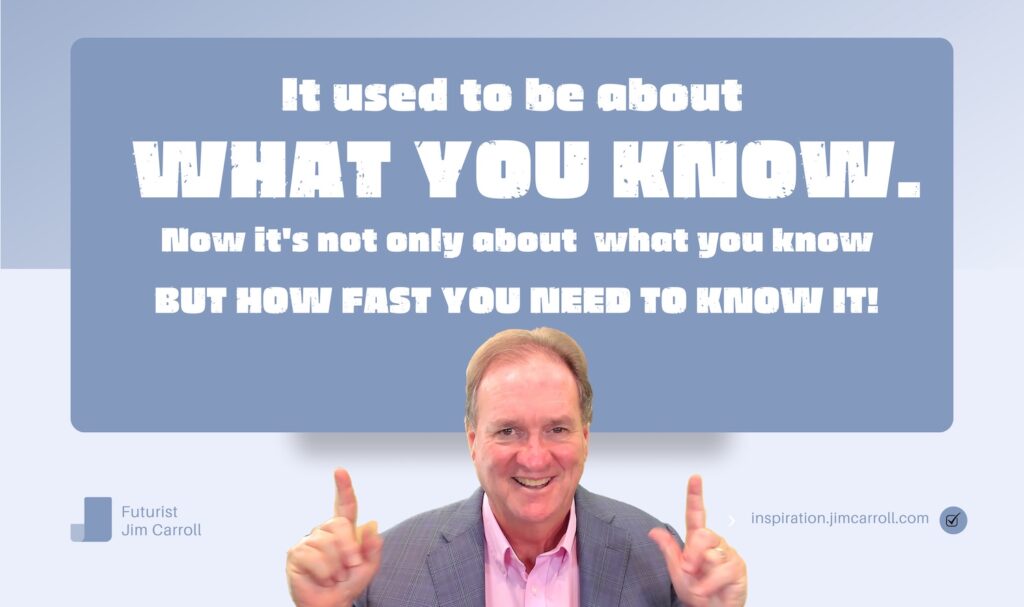
The Arrival of New Skills
Increasing knowledge velocity doesn’t just happen with existing skills. It happens with the fact that you will need new skills with new knowledge related to trend that are coming at you with staggering speed. Here’s a clip to grok over!
The slide I used? Right here!
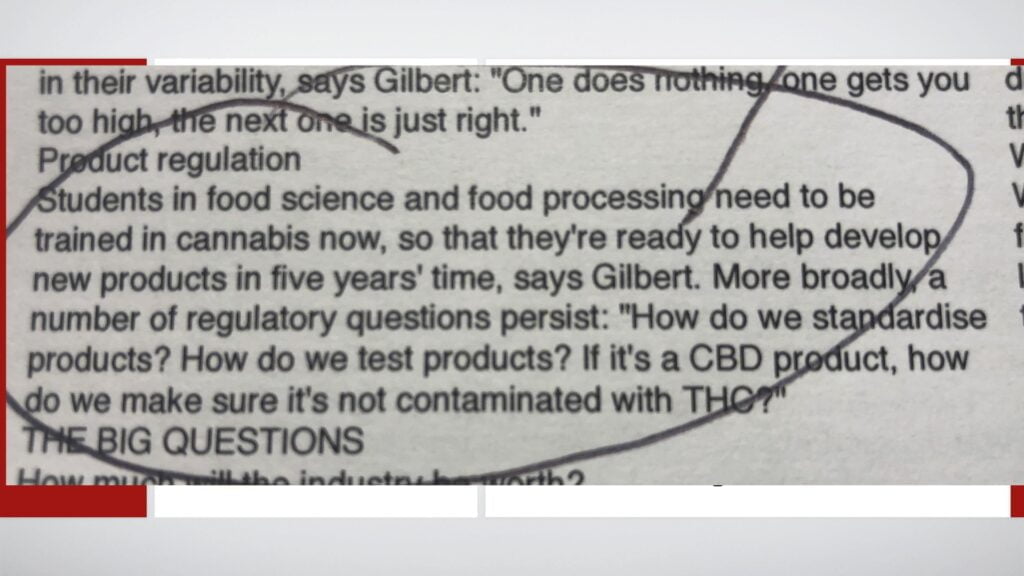
The point? Organizations always need to be thinking RIGHT now about the skills they might need in the future.
Students in food science and food processing need to be trained in cannabis now, so that they’re ready to help develop new products in five years’ time, says Gilbert. More broadly a number of regulatory questions persist: “How do we standardise products? How do we test products? If it’s a CBD product, how do we make sure it’s not contaminated with THC?
Watch the video clip – when I put this slide up in front of a bunch of senior executives for major food companies, they all quickly came to agree in a follow-up discussion that this was one of the biggest issues they are faced with.
The context of your future? It’s to be found in one of my previous Daily Inspiration posts. “You are going to need to recruit people for jobs not yet in existence based on skills not yet developed and you need to do this yesterday!” – Futurist Jim Carroll
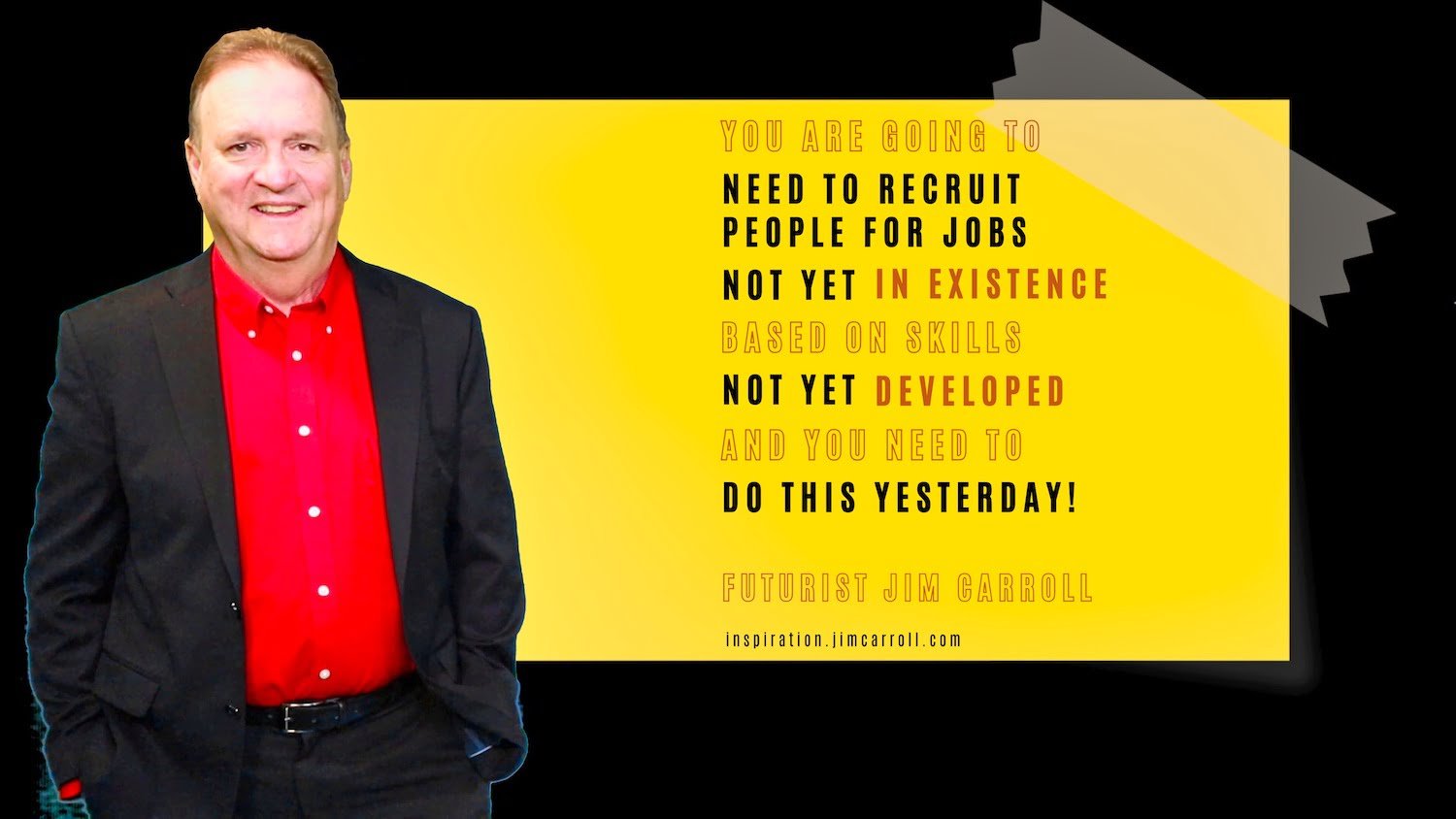
“It’s the jobs that do not yet exist that you really need to prepare for!” – Futurist Jim Carroll
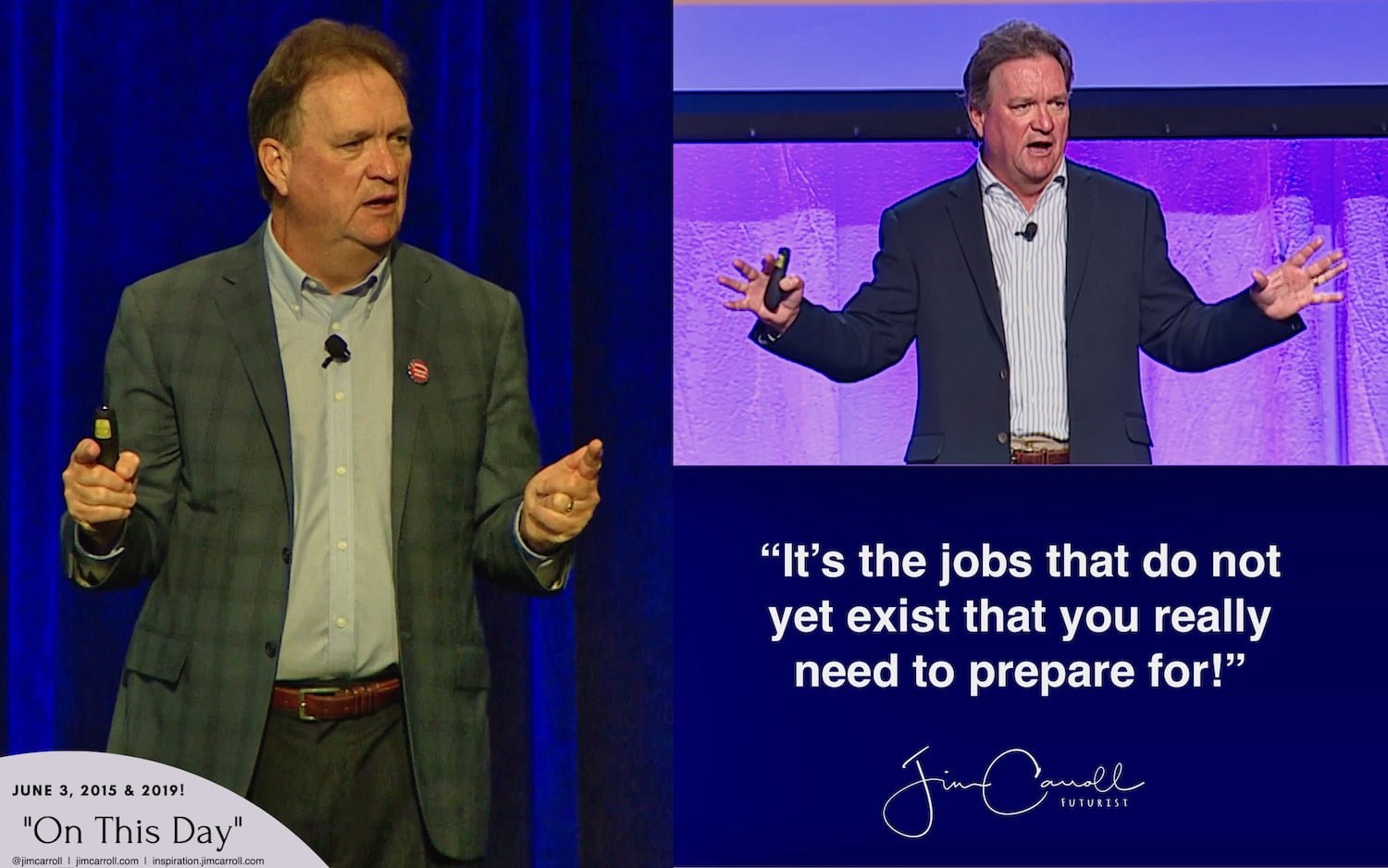
Consider all this in the context of a key bedrock quote that I’ve used for almost every keynote for close to 25 years – that 65% of kids in pre-school today will work in jobs or careers that do not yet exist. Here’s that opening in context:
I originally came across the prediction way back in 1997 in an Australian study; the original source material has long since disappeared.
Since then, this statistic has become a bit of a meme in the education, skills, HR, and knowledge industries; it was even often quoted throughout the Bush and Obama administrations. The fun part is that over the years, a few groups have tried to track down the source of the quote, and have made their way back to me; my original citation source has long since disappeared. Some take umbrage with the observation, demanding proof and scholastic attribution, which seems kind of quaint in the world of today in which it seems anybody can make up anything they like.
That key statistic has been one of three observations that I’ve often used to set the tone for my keynotes and the idea of accelerating change – the other two being that 1/2 of the knowledge for a typical college degree is obsolete or revised by the time of graduation and that most products are now obsolete within just a few years of release. Here’s another highlight clip of my first few minutes on stage at a manufacturing event in Chicago, setting the tone early on:
In New Orleans, I kicked things up a notch – check out this bold assertion as to what we really need to do to align to a faster future.
New jobs? New careers? I have no problem suggesting a few; there are dozens. Here are five to start your day thinking about:
- knowledge farmers: exponential knowledge growth, in part driven by social networking, is leading to information overload everywhere. KFs are the uber-editors who immerse themselves in global data feeds, extracting relevant knowledge and insight from data torrents. They’re the new editors, and it’s their ability to apply their insight to knowledge-rivers that will place them in high demand.
- location intelligence professionals: see my earlier post on this. I’ve been talking about this for years. These are the folks who are linking GoogleMap-type data to existing business processes and services, and who are building entire new global infrastructure on spatial information.
- mash managers: as innovation moves from the core to the masses, creative insight is emerging from those who learn how to take multiple new ideas, and input them into the innovation process. These people synthesize ideas from multiple sources, study markets, interpret insight, and decide how to re-evolve a product, service, brand, marketing campaign, or just about anything else. Their focus is “constant innovation,” and it’s their idea-immersive environment that drives them forward.
- tactical controllers: in this wildly information-chaotic world, some people are busy searching for the next big thing. A new and very real profession emerges with those who step beyond the “minutiae-of-the-moment” and instead focus on providing tactical, strategic guidance on what-to-do-in-the-next-moments … they are the PR expert who knows how to steer the company through a global viral idea meltdown; the brand expert who knows how to re-energize a brand next week; the individual who studies what the global knowledge farmers are revealing, and who understands what to do next as a result.
- analytical architects: the world’s big problems are being solved by those who are learning to throw sophisticated solutions at complex problems. These are the folks who will architect the smart-highway infrastructure; load-balanced two-way energy grids; just-next-week manufacturing processes for the era of the customization of one. They’ve combined education in combinatory theory with big server farms to generate the new smart infrastructure that is set to envelop us.
Reality? My son works as a drone pilot – a location intelligence professional. And with Covid-19, we’ve seen the emergence of vast numbers of analytical architects.
The future? It’s big, it’s bold, and it’s happening all around you!
CEOs are worried about knowledge velocity
Some time ago I was in Miami and did a talk on business disruption, transformation, and innovation for about 30 CEOs of companies in the healthcare, tech, and IT sectors, on behalf of a private equity firm. The meeting also included a wide-ranging discussion with a panel of ‘mentor’ ceos.
This is one of several events of this type I’ve done; through the years, an increasing number of private wealth, family offices, and private equity firms have brought me in for talks, including a keynote in Greece where there was about $1 trillion of value in the room. In the conclusion, I managed to query all of these CEO’s on the biggest perceived challenges they face going forward.
Check out their response! Talent and skills! Speed of change!
The issues in the poll were the ones that they raised as major concerns, during the discussion part of the meeting, and had to do with these issues:
- how does a CEO establish an appropriate balance between the necessity for leadership and the criticality of strategy time?
- how to best manage the speed of change
- how to align their team to emerging trends, challenges,s and opportunities
- getting the right talent at the right time for the right purpose
- establishing an overall organizational culture of speed
- how to manage the disconnect between needing to change and historical legacy (as well as legacy IT)
- managing more complex consumer expectations
- when to jump onto a major trend
This is just so interesting from several perspectives, but first and foremost is this: I’ve long explained to my clients that a key issue for any organization going forward is this: “getting the right skills at the right time for the right purpose.”
Put this in the context of several recent headlines I’ve used in events: GE hiring more tech talent and purchasing startups than Silicon Valley companies; Ford hiring 27,000 computer tech staff to help it in the race for self-driving cars; and other similar issues.
Clearly, talent is a major issue going forward, and workforce and skills innovation is rising to the top! Add knowledge acceleration to the issue and you’ve got your unique chalelnge for 2023.





GET IN TOUCH
Jim's Facebook page
You'll find Jim's latest videos on Youtube
Mastodon. What's on Jim's mind? Check his feed!
LinkedIn - reach out to Jim for a professional connection!
Flickr! Get inspired! A massive archive of all of Jim's daily inspirational quotes!
Instagram - the home for Jim's motivational mind!